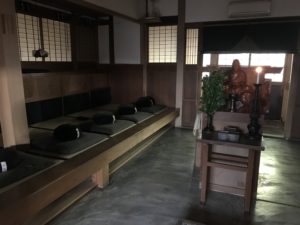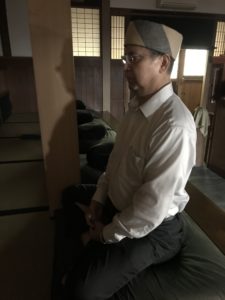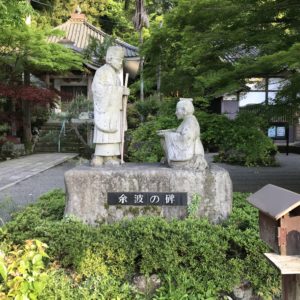禅って何?
「禅」という言葉を聞いて、パッと思い浮かぶイメージは何でしょう?
「坐禅、修行、悟り」といった、どこか近寄りがたいイメージかもしれません。あるいは「わびさびのある、洗練されている、シンプルな」といった、身近に感じられるイメージかもしれません。
元々「禅」という言葉は、坐禅を中心とした修行をする仏教の一派(禅宗)の中で使われる、いわば宗教用語でした。
ですが「禅(Zen)」は、今や「生活スタイル」や「製品デザイン」を表す言葉としても一般的になり、本や雑誌の特集で目にすることも増えました。
集中力を高める・気持ちを落ち着かせるため、坐禅を体験する人も増えているようです。
しかし、改めて「禅とは何か?」と問われると、シンプルに答えることは難しいものです。

坐禅堂

坐禅堂(続き)
永平寺の禅
私(寺尾)のいる福井県には、永平寺という禅寺があります。
人里離れた山奥にあり、冬は雪に閉ざされる、秘境にあるような禅寺ですが、日本のみならず、世界的にも非常に有名な禅寺です。
この永平寺は、三大禅宗の一つ、曹洞宗の大本山(本部)です。
開祖・道元による建立から約800年の歴史があり、全国から修行僧が集う修行道場でもあります。
永平寺を中心とする曹洞宗の禅(以下、禅)は、約800年前の建立当時に定められた厳しい戒律をずっと守り続け、今に至っています。
坐禅を基本としながら、朝の洗顔から食事の作法まで、生活の所作が事細かに定められており、「日々の生活で禅を実践する」ことを重視します。

永平寺(山門)
■ 永平寺・修行僧の一日(イメージ)
03:30 起床・洗顔
03:45 坐禅(約40分)
04:30 読経
06:30 説法
07:00 朝食
08:00 廊下の雑巾がけなど(作務)・講義
11:00 読経
12:00 昼食
13:00 掃き掃除や下草刈りなど(作務)・講義
16:00 読経
17:00 夕食
18:00 講義・説法
19:00 坐禅(約40分)
20:00 坐禅(約40分)
21:00 就寝
修行僧の一日、いかがでしょう?
禅の修行というと「一日中、心穏やかに坐禅をしている」という「静」の修行がイメージされますが、実際は起床から就寝まで、肉体的・精神的に目まぐるしい「動」の修行です。
坐禅は、基本的に一日3回(朝1回・夜2回)。
その他は、掃除などの作業(作務)が日中の多くの時間を占めています。庭や境内の掃除、雪囲いなどの作業(作務)も修行の一つですから、手際よく徹底的に行います。
食事は、少量の粥とおかずが基本のため、目まぐるしい修行を行う修行僧は常に空腹に耐えなければいけません。栄養の偏りから脚気(ビタミン不足)になる修行僧も出るようです。
「日々の生活が修行」、その言葉に偽りのない厳しい修行と言えるでしょう。
修行僧の修行期間に明確な定めはありませんが、平均すると約2年で修行を終え、全国の曹洞宗のお寺に僧侶として戻るようです。
この永平寺の存在により、福井という土地は「禅」が身近にあります。
私自身も、「日々の生活が修行である」という禅の教えに共感するところがあり、週に一回、曹洞宗の禅寺に参禅して坐禅をしています。

坐禅中…。
『正法眼蔵』について
永平寺を建立した道元は、自身の説く「仏法の教え」と「その実践方法」を『正法眼蔵(しょうぼうげんぞう)』という書物に書き記しています(未完)。
この『正法眼蔵』は「曹洞宗の聖典」と言えるもので、今に至るまで約800年、その教えは厳格に守られてきました。
『正法眼蔵』自体は、巻数も膨大、内容も難解なため、いわゆる「読書感覚」で気軽に読めるものではありません。仏教思想家「ひろさちや」さんも、『正法眼蔵』を読むのであれば、一般的な禅の解説書としてではなく、「仏教を理解する智慧を言語化しようとした哲学的思索の跡」(哲学書)として読むことを勧めています。禅に興味のある方は、まずは書店に並んでいる「禅の入門書」を手に取ってイメージを掴んでみると良いでしょう。写真も解説も豊富で分かりやすいです。

禅寺と石庭

芭蕉と句碑
禅についての理解
私の禅についての理解も、まだ発展途上にあります。禅の理解を深める上で、テレビ番組「100分de名著 」(NHK・Eテレ)が大いに参考になりました。『正法眼蔵』特集(2016年11月放送)では、先述の仏教思想家「ひろさちや」さんがとても分かりやすい解説をしていて印象に残りました。この放送の解説テキストは、『100分de名著 道元 正法眼蔵』(NHK出版,2016年)として発売されています。
「100分de名著 」では、「禅のエッセンス(思想原理、思想のキー・コンセプト)」を次の4つに分類しています。
■ 4つのエッセンス
1. 身心脱落(しんじん・だつらく)
・・・・ 身も心も空っぽに。
2. 諸法実相(しょほう・じっそう)
・・・・ すべてあるがままに。
3. 修証一等(しゅうしょう・いっとう)
・・・・ 修行も悟りも同じもの。
4. 只管打坐(しかん・たざ)
・・・・ 生活のすべてが修行。
一読して、いかがですか?
「シンプル、かつ、難解」いわば「結論だけ」なので、きっと面食らったことでしょう。
しかし、その結論に至る「過程や思考」を知ると「なるほど!」と感じられると思います。
まずは、禅における「悟り」の考え方から始めていきましょう。
「悟り」と聞いて、思い浮かべるイメージはどんなものですか?
「厳しい修行の末にようやく得るのが悟り。悟れば、悩むこともなく心安らかになる…。」
これが、多くの人が「悟り」について抱くイメージではないでしょうか。
実は、禅宗では「人間は皆生まれながらにして、すでに『悟っている状態』」と考えます。
つまり「悟り」は、厳しい修行をして「得る・至る」ものではなく、生まれながらに「備わっている」ものなのです。
では、生まれながらに悟っているのなら、なぜ修行をする必要があるのでしょう?
それには「自我」が大きく関係しています。「自我」は「わたしは私」という意識です。
自我があることで、私たちは「わたし自身」と「わたし以外(他人・世の中)」を区別します。
つまり「わたしとあなたは違う存在」という自覚です。この自覚があるからこそ、コミュニケーション(意思疎通)が成立します。
わたし以外の相手がいるからこそ、一緒に頑張る、励ましあう、喜びを分かち合う、そういう素晴らしい感情が芽生えます。これは、わたし一人だけでは生じない感情です。
しかし一方、欲望、怒り・妬み、不安・悩み、疑い・迷いといった煩悩(ぼんのう)も、わたし自身とわたし以外の相手を比較するからこそ生じる感情です。
自我があること自体は、良くも悪くもありません。
問題は、自我が他人に対する過剰な対抗意識や競争意識につながることです。
それならば、「そんな自我は、いっそ投げ捨ててしまえ!」というのが、1.身心脱落、2.諸法実相という考えです。
「悟り」というのは、「自我も価値判断もなく、自分も他人もすべての存在が等しく一つに溶け合っている状態」です。
もし悟りを求めてしまうと、自我を持って価値判断をしてしまうことになります。
これでは「自分と他人が溶け合っている状態」になることは決してありません。
つまり「悟り」とは蜃気楼のようなもので、求めると遠ざかり、決して辿りつけないものです。
悟りを求めても得られないのであれば、悟りを求める「自我」の方を消滅させて「悟りの世界」に溶け込む。道元の記した1.身心脱落、2.諸法実相は、そんな逆転の思考法なのです。
「悟りの世界」とは、自我も価値判断もない「ただあるがままの世界」と言えます。
ですから、悟りは一般のイメージとは大きく違うものです。
悟りは「求める」ものではなく、「手放す」ものなのです。
禅のエッセンスをまとめると、以下の4つになります。
1. 身心脱落(しんじん・だつらく)
・・・・ 悟りは求めても得られるものではない。悟りを求めている自己を消滅させるのだ。
2. 諸法実相(しょほう・じっそう)
・・・・ わたしたちの目の前にある、ありのままの世界を認識し、「いま」、「ここにある」、「このわたしを」生きるのだ。
3. 修証一等(しゅうしょう・いっとう)
・・・・ 悟りを得るために修行をするのではない。悟りのなかにいる仏であるからこそ修行できるのだ。
4. 只管打坐(しかん・たざ)
・・・・ 坐禅だけが修行ではない。ひたすら坐り抜き、歩き抜く。その姿こそが仏であり、悟りである。
道元のラスト・メッセージ
曹洞宗の聖典と言える『正法眼蔵(しょうぼうげんぞう)』ですが、道元は、この大著を書き終える前に没しました。道元は亡くなる直前まで、この本の「八大人覚(はちだいじんかく)」という巻を書いていました。つまり道元の絶筆となった巻です。
この「八大人覚」の巻には、「大人」として自覚すべきことが示されています。
道元の言う「大人」とは、生物学的に成長しただけの「おとな」ではなく、真に人間としてふさわしい分別を備えた「人物」を指します。その分別とは、以下の8つです。
1. 小欲(しょうよく)
・・・・ 物足りないものを、あえて物足りないままにしておく。
2. 知足(ちそく)
・・・・ 与えられたもの全部を、自分のものとしない。他人のために一部を回す。
3. 楽寂静(ぎょうじゃくじょう)
・・・・ 静寂を楽しみ、騒がしい場所を離れる。
4. 勤精進(ごんしょうじん)
・・・・ 善き事に努力する。ただし、自分一人の利益のために頑張らない。
5. 不忘念(ふもうねん)
・・・・ 常に仏の教えを忘れない。
6. 修禅定(しゅぜんじょう)
・・・・ 心静かに瞑想し、真理を観察する。
7. 修智慧(しゅちえ)
・・・・物事をあるがままに見ることができる「眼」を養う。
8. 不戯論(ふけろん)
・・・・ 無駄な議論はしない。物事をあるがままに単純そのままに受け取る。
What is Zen?
When you hear the word “Zen”, what image springs to mind?
Perhaps it’s an image that is somewhat unapproachable, such as “zazen, training, enlightenment”. Or perhaps it’s an image that feels familiar, such as “refined, simple, with a sense of wabi-sabi”.
Originally, the word “Zen” was a religious term used within a sect of Buddhism (Zen Buddhism) that practiced training centered around zazen.
However, the word “Zen” has now become a common term for “lifestyle” and “product design”, and you can see it more and more in book and magazine features.
It seems that more and more people are trying zazen to improve their concentration and calm their minds.
However, when you ask “what is Zen?” again, it’s difficult to give a simple answer.
Zazendo Zazendo (cont.)


Zen at Eiheiji
In Fukui Prefecture, where I (Terao) live, there is a Zen temple called Eiheiji.
It is a Zen temple that is located deep in the mountains, far from civilization, and is cut off by snow in winter, but it is a very famous Zen temple not only in Japan but also around the world.
Eiheiji is the head temple of the Soto school, one of the three major Zen schools.
It has a history of about 800 years since it was founded by the founder, Dogen, and it is also a training temple where trainee monks gather from all over the country.
The Soto Zen sect of Buddhism, centered around Eiheiji Temple, has continued to observe the strict precepts established at the time of its founding some 800 years ago to this day.
While zazen (seated meditation) is the foundation of the practice, the details of daily life, from washing one’s face in the morning to the manner of eating, are all strictly regulated, with an emphasis on “practicing Zen in one’s daily life”.
Eiheiji (Main Gate)

■ A day in the life of a trainee monk at Eiheiji (image)
03:30 Wake up, wash face
03:45 Zazen (about 40 minutes)
04:30 Chanting
06:30 Sermon
07:00 Breakfast
08:00 Cleaning the corridors, etc. (samu) / Lecture
11:00 Chanting
12:00 Lunch
13:00 Sweeping, weeding, etc. (samu) / Lecture
16:00 Chanting
17:00 Dinner
18:00 Lecture / Sermon
19:00 Zazen (about 40 minutes)
20:00 Zazen (about 40 minutes)
21:00 Go to bed
What do you think of a day in the life of a trainee monk?
When we think of Zen training, we imagine a quiet practice of sitting calmly in zazen throughout the day, but in reality it is a hectic practice of physical and mental activity from waking up to going to bed.
Zazen is basically done three times a day (once in the morning and twice at night).
Other than that, work such as cleaning (samu) takes up much of the time during the day. Cleaning the garden and temple grounds, and work such as snow fencing (samu) are also part of the training, so they are carried out efficiently and thoroughly.
As the basic diet consists of a small amount of rice porridge and side dishes, the monks who are engaged in intense training have to constantly endure hunger. Some of the monks may even suffer from beriberi (a vitamin deficiency) due to the lack of nutrition.
The phrase “daily life is training” is a phrase that truly describes the harsh training that the monks undergo.
There is no fixed period for the training of the monks, but on average, they complete their training after about two years and return to their home temples as priests.
Thanks to the existence of Eiheiji, the Zen tradition is very close to the people of Fukui.
I myself also share the Zen teaching that “daily life is a form of training”, and I go to a Soto Zen temple once a week to practice zazen.
During zazen…

About the Shobogenzo
Dogen, who founded Eiheiji, wrote down the “Buddhist teachings” and “methods of practice” that he preached in a book called “Shobogenzo” (unfinished).
This “Shobogenzo” can be called the “holy scripture of the Soto sect”, and its teachings have been strictly observed for about 800 years to the present day.
The Shobogenzo itself is a huge work with a difficult content, so it is not something that can be read casually with a so-called “reading mindset”. The Buddhist thinker Hirosachiya also recommends that if you are going to read the Shobogenzo, you should do so not as a general commentary on Zen, but as “a philosophical contemplation that attempts to verbalize the wisdom to understand Buddhism” (a philosophical book). If you are interested in Zen, you might want to pick up one of the introductory books on Zen that you can find in bookstores to get a better idea of what it is about. They are easy to understand, with lots of photos and explanations.
Zen temple and stone garden Basho and haiku monument


My understanding of Zen
My understanding of Zen is still developing. In deepening my understanding of Zen, the TV program “100-minute de Meicho” (NHK E-television) was very helpful. In the “Shobogenzo” special (broadcast in November 2016), the aforementioned Buddhist thinker Hiroshi Chaya gave a very easy-to-understand commentary that left a strong impression. The commentary text for this broadcast has been published as “100-minute de Meicho: Dogen Shobogenzo” (NHK Publishing, 2016).
In “100-minute de Meicho”, the “Essence of Zen (philosophical principles, key concepts of thought)” is divided into the following four categories.
■ Four Essences
1. Shinjin-datsuraku (emptying the mind and body)
… Emptying the mind and body.
2. Shohoh Jisso (
“All things are as they are.”
3. Shusho Itto (
“Practice and enlightenment are the same thing.”
4. Shikan Taza (
“All of life is practice.”
What do you think after reading it once?
It’s “simple, yet difficult to understand” – in other words, it’s “just the conclusion”, so you’re probably a little taken aback.
However, if you know the “process and thinking” that lead to that conclusion, you’ll probably think “I see!
Let’s start with the concept of ‘enlightenment’ in Zen.
What kind of image comes to mind when you hear the word ‘enlightenment’?
“Enlightenment is something that you finally attain after undergoing strict training. Once you’ve attained enlightenment, you won’t have any worries and your mind will be at peace…”
This is probably the image that most people have of enlightenment.
In fact, in Zen Buddhism, it is thought that “all human beings are already in a state of enlightenment by nature”.
In other words, enlightenment is not something that you “attain or reach” through rigorous training, but something that is “inherent” from birth.
So, if we are already enlightened by nature, why is it necessary to train?
The ego is a major factor here. The ego is the consciousness of “I am I”.
The ego allows us to distinguish between “myself” and “others (other people, the world)”.
In other words, it is the awareness that “you and I are different beings”. It is this awareness that allows communication to take place.
It is because there are other people besides myself that we can work hard together, encourage each other, and share our joy. These are wonderful feelings that would not arise if it were just me alone.
However, on the other hand, desires, anger and envy, anxiety and worry, doubt and hesitation, and other worldly desires also arise because I compare myself to other people.
The existence of the ego itself is neither good nor bad.
The problem is that the ego can lead to excessive competitiveness and a sense of rivalry towards other people.
If that is the case, then the idea is to “throw away that ego!” This is the idea of 1. dropping the body and mind and 2. the reality of all phenomena.
Enlightenment” is a state where ‘there is no ego or value judgments, and all beings, including yourself and others, are equally one and the same’.
If you seek enlightenment, you will end up having an ego and making value judgments.
In this way, it is impossible to achieve a state where “you and others are one”.
In other words, “enlightenment” is like a mirage: if you seek it, it will recede, and you will never reach it.
If you seek enlightenment but cannot attain it, you should let go of your “self” that seeks enlightenment and dissolve into the “enlightened world”. Dogen’s writings on 1. dropping the body and mind and 2. the true nature of all phenomena are such a way of thinking that reverses the usual way of thinking.
The “world of enlightenment” can be said to be a world where there is neither ego nor value judgments, but rather a world “as it is”.
Therefore, enlightenment is very different from the general image of it.
Enlightenment is not something that is “sought”, but rather something that is “given up”.
The essence of Zen can be summarized in the following four points.
1. Shinjin-datsuraku (mind-body detachment)
… Enlightenment cannot be obtained by seeking it. The self that is seeking enlightenment must be annihilated.
2. Shohoh Jisso (
“The true nature of all things is as it is”)
… Recognize the world as it is right in front of you, and live “here and now” “as I am”.
3. Shusho Itto (
“The highest state of practice and realization”)
… You don’t practice in order to attain enlightenment. You can practice because you are already a Buddha in enlightenment.
4. Shikantaza (
“Just Sitting”) ・・・・ Zazen is not the only form of practice. Just sitting and walking through to the end. That form is the Buddha and enlightenment.
Dogen’s Last Message
Shobogenzo is the sacred scripture of the Soto sect, but Dogen passed away before he could finish writing this great work. Until shortly before his death, Dogen was writing the “Hachidaishin-kaku” (Eight Great Realizations) section of this book. In other words, this was the final section of his writings.
In the “Hachidaishin-kaku” section, Dogen shows us what we should be aware of as “adults”.
Dogen’s idea of an “adult” is not someone who has simply grown up biologically, but someone who has the wisdom befitting a true human being. This wisdom is made up of the following eight points.
1. Small desires (shōyoku)
… When something is lacking, leave it as it is.
2. Contentment (chisoku)
… Do not take everything that is given to you as your own. Give some of it to others.
3. Gyojakujo (tranquility and quietude)
… Enjoy the quiet and leave noisy places.
4. Gonshojin (diligence and sincerity)
… Work hard at good things, but not for your own personal gain.
5. Fumonenn (forgetting the past)
… Always remember the teachings of Buddha.
6. Shuzenjo (meditation)
… Meditate in a quiet state of mind and observe the truth.
7. Cultivate wisdom (shu-chie)
… Cultivate the “eyes” that can see things as they are.
8. Do not argue (fuke-ron)
… Do not engage in pointless arguments. Accept things as they are, simply as they are.